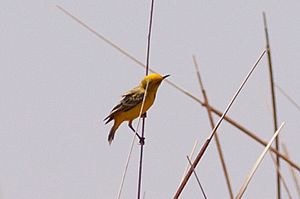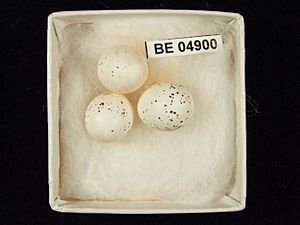Yellow chat facts for kids
Quick facts for kids Yellow chat |
|
|---|---|
 |
|
| Conservation status | |
| Scientific classification | |
| Genus: |
Epthianura
|
| Species: |
crocea
|
The yellow chat (Epthianura crocea) is a small bird found only in Australia. These birds are known for their amazing ways of surviving in their dry homes. They are very good at living in hot, dry places where water is hard to find.
Contents
What is a Yellow Chat?
The yellow chat is a type of passerine bird. This means it's a perching bird, like many songbirds. It belongs to the family Meliphagidae, which includes honeyeaters. Scientists first thought yellow chats were in their own family. But then they found out these birds have a special brush-like tongue. DNA tests also showed they are related to honeyeaters.
There are four types of birds in the Epthianura group. Besides the yellow chat, there are the crimson chat, the orange chat, and the white-fronted chat.
The name Epthianura was given by John Gould in 1838. It might come from an Ancient Greek word meaning 'refined' or 'wasting away'. The 'oura' part means 'tail'. This refers to how Gould described chats as having a "short tail". The second part of its name, crocea, is Latin for 'golden-yellow'.
Scientists first thought there were four different kinds of yellow chats. Now, only three are officially recognized. These different types are mostly known by the colors of the adult males during breeding season.
- Epthianura crocea crocea lives in the Kimberley area. It is also found near the Gulf of Carpentaria and the Lake Eyre Basin.
- Epthianura crocea tunneyi lives in a small area of floodplains. This is from the Adelaide River to the East Alligator River.
- Epthianura crocea macgregori is also called the Capricorn yellow chat. It lives along the coast of central Queensland. This type of yellow chat is considered critically endangered. This means it is at a very high risk of disappearing forever.
What Does a Yellow Chat Look Like?
Yellow chats are small birds, usually seen in groups of 2 to 10. They are about 11 cm (4.3 in) tall. They weigh around 9 g (0.32 oz), which is very light.
Male and female yellow chats look different. The adult male has a bright golden-yellow head and belly. He also has a clear black band across his chest. His head and neck are grey-olive, and his back is yellowish-brown. His tail is black with yellow tips on the feathers.
The female has similar colors but is a lighter yellow. She does not have the black chest band. Young yellow chats are more greyish-brown than their parents. All yellow chats, even young ones, have a bright yellow patch on their rump when they fly. This helps identify them.
They have long legs and toes. This helps them find food easily on the ground or in low plants. Yellow chats also have a special, high-pitched call. It sounds like pee pee.
Where Do Yellow Chats Live?
Yellow chats live in different parts of northern Australia. They are found in dry areas from South Australia to the Northern Territory. Some groups also live in eastern Queensland and Western Australia.
Their homes are usually very hot for most of the year. They live in marshy plains. These areas have plants like saltbush, tall grasses, or cumbungi reeds. These wet areas are often formed by ocean lagoons or water from underground springs. This makes the environment salty.
Most of the rain in these areas falls during the summer monsoon season. For the other six months of the year, there is very little rain.
How Do Yellow Chats Survive in Dry Places?
It might seem hard for yellow chats to live in such hot, dry places. They are small birds, so they might lose water quickly. Small birds also tend to use a lot of energy. This could lead to heat stress and losing too much water. This would be a big problem where water is scarce.
But yellow chats do very well in their hot, dry homes. Scientists have found that their bodies are special. They have ways to cope with the challenging environment. Studies show they can use less energy and lose less water.
Their body controls how much energy they use with a hormone. Yellow chats have lower levels of this hormone. This makes their bodies work slower. This helps them live in their harsh, hot, and dry environment.
Another special thing about yellow chats is their brush-like tongue. This tongue might help them get drinking water. It lets them drink dew or thin layers of water from plants.
Also, their yellow color helps them stay cool. Dark colors absorb more heat from the sun. Lighter colors absorb less heat. So, the yellow color of these birds helps them avoid getting too hot.
Yellow Chat Behavior
What Do Yellow Chats Eat?
Yellow chats mainly eat insects. They look for their food in damp soil, low plants, or shallow water.
Reproduction and Life Cycle
Yellow chats usually breed from November to January. This happens after enough rain has fallen. When breeding season starts, the groups of birds spread out. Male and female pairs then form. The male stays with his mate until she starts laying eggs.
The male protects their nesting area. He makes clicking sounds with his bill and chases away other birds. The female builds the nest close to the ground. She usually builds it in small shrubs, like samphire, or in thick grass.
Nests are made from small twigs, roots, and grasses. The inside of the nest is lined with soft materials like hair, often from horses or cows, and fine grasses. The female lays two or three eggs. They are white to pinkish-white and have reddish-brown spots. Each egg is about 17 mm × 13 mm (0.67 in × 0.51 in).
Both the male and female take turns sitting on the eggs. This is called incubation. It takes about two weeks for the eggs to hatch.
See also
 In Spanish: Eptianuro amarillo para niños
In Spanish: Eptianuro amarillo para niños
Images for kids





